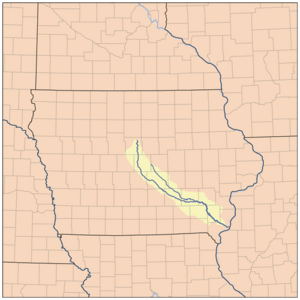Skunk River facts for kids
Quick facts for kids Skunk River |
|
|---|---|

Map showing the Skunk river, including both branches.
|
|
| Country | United States |
| State | Iowa |
| District | Lee County, Iowa, Des Moines County, Iowa, Poweshiek County, Iowa, Henry County, Iowa, Jefferson County, Iowa, Washington County, Iowa, Keokuk County, Iowa, Jasper County, Iowa, Story County, Iowa, Mahaska County, Iowa, Marshall County, Iowa |
| Physical characteristics | |
| Main source | 41°14′53″N 92°01′34″W / 41.248°N 92.026°W |
| River mouth | Mississippi River Burlington, Iowa, US 522 ft (159 m) 40°41′53″N 91°06′54″W / 40.698°N 91.115°W |
| Basin features | |
| Tributaries |
|
The Skunk River is a 93-mile-long (150 km) river in Iowa, United States. It flows into the mighty Mississippi River. This river is an important part of Iowa's natural landscape.
Contents
Where Does the Skunk River Flow?
The Skunk River actually starts as two main parts. These are called the South Skunk River and the North Skunk River.
The South Skunk River's Journey
The South Skunk River is about 185 miles (298 km) long. It begins in Hamilton County, Iowa, which is in north-central Iowa. This branch flows mostly south, staying west of Interstate 35. It passes through the city of Ames, Iowa. After Ames, it turns to flow southeast.
The North Skunk River's Path
The North Skunk River is shorter, about 129 miles (208 km) long. Its journey starts in Marshall County, Iowa.
Where the Branches Meet
The two branches, North and South Skunk, join together in Keokuk County, Iowa. After they meet, the combined Skunk River continues flowing southeast. It finally empties into the Mississippi River. This meeting point is about five miles south of the city of Burlington, Iowa.
What's in a Name? The Skunk River's History
The name "Skunk River" might sound a bit funny! It comes from the Sauk and Meskwaki Native American tribes. They called the river "Shecaqua."
A Possible Mistranslation
It's believed that "Shecaqua" was not translated perfectly into English. An early settler shared what an interpreter said. The interpreter explained that "Checaqua" in their language means anything with a strong or bad smell. This could be like onions.
The "Onion River" Theory
Because the areas near the river's start had many wild onions, some think the name should have been "Onion River." So, the Skunk River might have originally been known for its wild onions, not for skunks!
What Animals Live in the Skunk River?
The Skunk River is home to many different kinds of fish. It's a great place for aquatic life.
Fish Species You Might Find
Here are some of the fish that live in the Skunk River:
- Smallmouth bass
- Gar
- Walleye
- Catfish
- Carp
- Bluegill
- Sheephead
- Bullhead
- Largemouth bass
- Crappie
- Sunfish
Who Helps the Skunk River?
For many years, a group called the "Skunk River Navy" helped keep the river clean and healthy.
The Skunk River Navy was started by two Iowa State University professors, Jim Colbert and Jim Holtz. They were known as 'Admiral' Jim Colbert and 'Admiral' Jim Holtz. This group worked from August 1998 to September 2017. Their main goals were:
- To watch and study the different kinds of plants and animals in the South Skunk River. They also looked at some smaller streams that flow into it near Ames, Iowa.
- To remove trash from these rivers and streams.
Volunteers and Impact
Many people helped the Skunk River Navy. Most were students studying biology at Iowa State University. However, students from other majors, university staff, and other people also joined in. During the years the group was active, about 2,400 volunteers helped out. They removed over 80 tons of trash from the South Skunk River and its smaller streams.
The Skunk River Navy also found and reported pollution. They reported diesel fuel leaks and sewage leaks into the river. The city of Ames fixed these problems.
The Legacy Continues
After 2017, the Skunk River Navy stopped being part of the Iowa State University Biology Program. However, local groups who enjoy paddling on the river can still use the name "Skunk River Navy." This shows how important their work was for the river.

